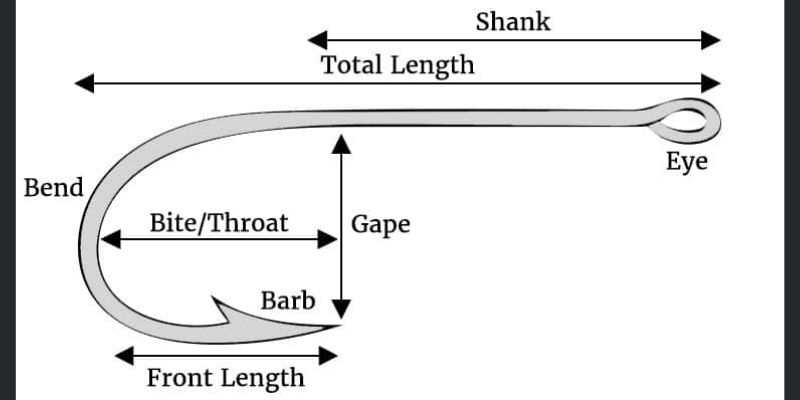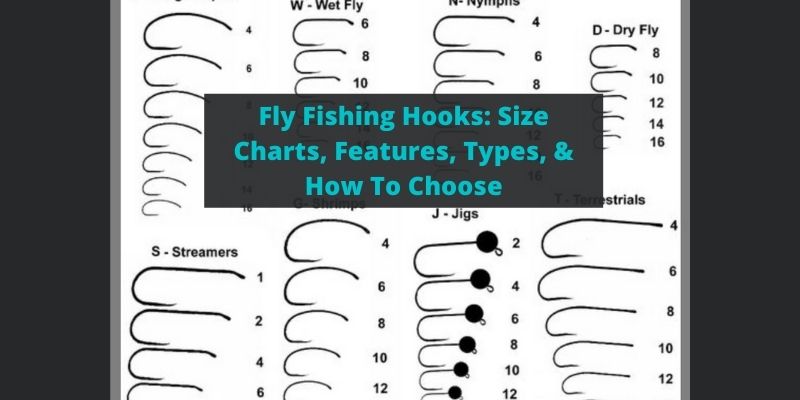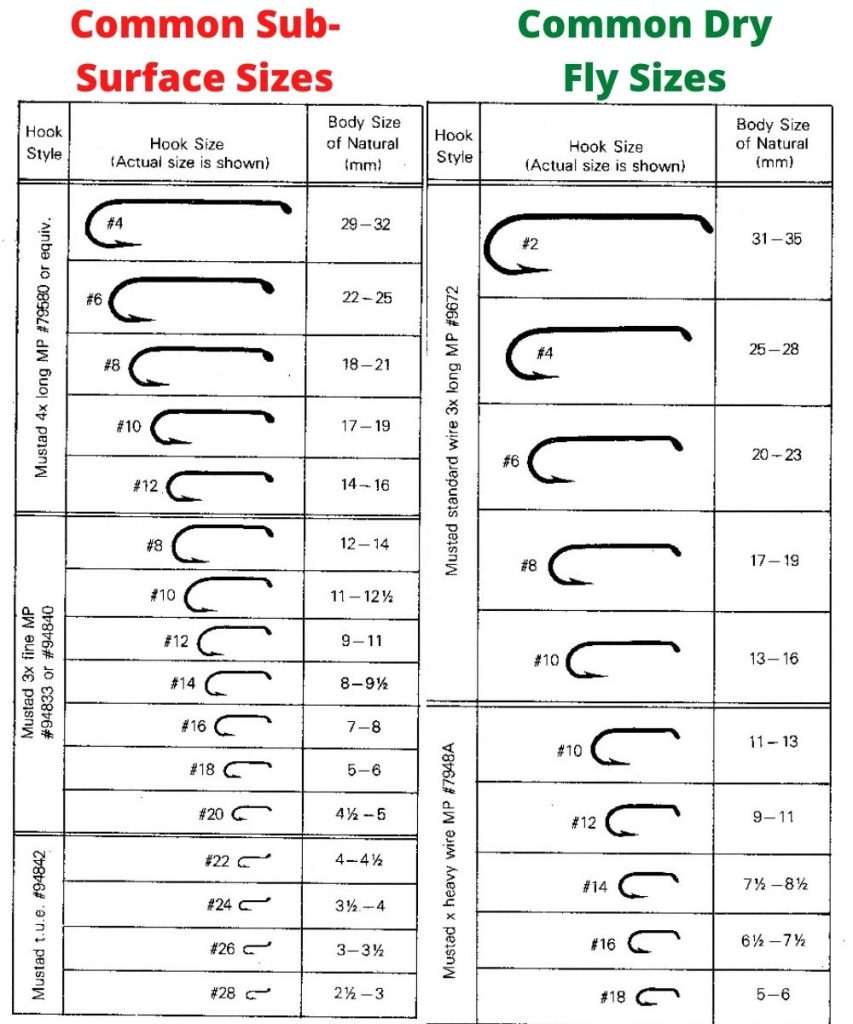When you’re tying flies for fishing, you have to tie them to something– and that’s the hook! Fly fishing hooks are extremely important in fly fishing. Good hooks are durable, remain sharp, and help anglers land more fish. No matter how great your rod is or how strong your line is, using the wrong hook could means that you are not able to land your fish.
There are a lot of hook options out there, and choosing the right one can be hard. In this guide, we’ll walk you through all the parts of the hook and how they all come together to help you catch fish. Then, we’ll talk about what some of the different hook sizes are and how to pick the ones you should have for your fishing needs.
Anatomy of a Hook
A hook may look simple, but several different parts make one hook more effective than another in any given situation. You also should know a little bit about how hook sizes are determined so that you can make sure to grab the right hook to use as a base to tie your flies.

Fishing Hook Parts Diagram
Hook Size
Before you start tying your first fly, you need to know the size of the hook necessary for that pattern. The most common fly hooks range from size 1 to size 32. The lower the number, the larger the hook (just like with tippet and leader, or wire gauge).
Sizes are determined by the length of metal used to make the hook. This means that sometimes you’ll see an x-rating (2xl, 4xl, 6xl, etc) scale on hooks that have longer or shorter shank sizes, which have been added to keep the hook gap and maintain the actual size of the hook. For example, a 1x long shaft on a size 14 hook is going to be the length of a size 12 hook. You’ll see this working on smaller shanks, too. A 1x short shank on a size 12 would be the size of a 14. This keeps the gap the same size but allows the hooks to be longer or shorter.
This diagram will help you visualize hook sizes:
Hook Gap
A hook gap is the distance between the bend and the point of the hook. Some anglers like a wider hook gap, because it’s more forgiving and will hook into a fish more easily. However, if your hook gap is too large, it becomes easier for a large fish to pull it out of shape and escape. This is only a risk with very strong fish or very lightweight hooks. The generally accepted advice is that it’s better to go wider.

Hook Shank
If you think of a hook as being shaped like a capital J, the shank is the straight part of the letter, right before it curves. (The hook bend is the bottom of the J.) The shank is what you tie your fly to, so make sure to find a shank length that works with your preferred pattern. Some shanks have different angles that help mimic various insects; for example, some patterns call for angled shanks to mimic long, skinny insects better.
Hook Bend
The hook bend is right where the hook starts to curve. There are different types of hook bends based on the angle of curvature. For most trout flies, hooks either have a round bend or a sproat bend, but there are a few different ones that are sometimes called for, such as the Limerick bend, the York bend, and the Perfect bend. The bend isn’t as important as other parts of the hook, so you don’t need to worry about it too much.
Barb and Point
The point is the sharp part of the hook. It’s what the fish hit when they bite your fly. Hooks with barbs have a little ridge of metal on the point that helps to lock the fish in place. However, many fisheries now require barbless hooks. Barbed hooks can cause significant damage very easily, and as many areas for fly fishing are catch and release, the goal is to release the fish with as little damage as possible. If you have a bunch of barbed hooks and want to make them barbless, you can use a pair of pliers to flatten the barb.
Hook-Eye
The hook eye is the loop at the top of the hook shank that you thread your tippet through. There are four main types of hook eyes, but the most popular is the straight eye. The straight eye allows for more room in the gap and increases leverage on your hook set. This is an eye that simply runs straight up and down in the same direction as the hook shank. Upturned hook eyes are angled away from the hook’s point, and downturned eyes are angled towards the hook’s point.
There is one more type of hook eye that is gaining popularity in the professional fly fishing scene, and that’s the jig eye. Jig eye hooks have the eye set at a 90° angle, perpendicular to the shank. This allows more movement of the fly in the water, which can be very enticing to fish!
Types of Hooks
Different fishing techniques and goals will require different kinds of hooks. These hooks can be found in many different sizes, but most don’t go all the way to one end of the spectrum or the other. You’d never go nymphing with a big saltwater hook. Here are the general specifications for different types of fly fishing hooks. Keep in mind, that these are just guidelines, and anglers can still mix and match hooks if needed for certain situations, though that’s not ideal! (If you want to watch a video for this section, scroll to the bottom of this section.)

Nymphing Hooks
Because nymphing involves sinking your fly, nymphing hooks are usually made from heavier wire. This is to help your nymph sink and move appropriately. They typically have round bends and either straight or downturned hook eyes. Nymphing hooks are also frequently found with angled shanks, to better mimic the insects represented in nymphing patterns. Nymphing hooks come in various shapes and sizes, but those shapes and sizes are meant to mimic specific bug stages. These hooks can also be great for emergers. Emerging flies may be better suited for a thinner gauge hook as they may not need to sink as much.
Nymphing hooks can have longer and shorter shanks depending upon the type of nymph being tied. It can be curved, long, or short, but mainly, nymph hooks will have thicker gauge.
See Nymphing Hooks On Amazon | See On Orvis
Dry Fly Hooks
Dry-fly fly-fishing hooks need to be lightweight, so they are made from thinner wire. Many dry fly hooks have downturned eyes to help the fly sit nicely on the surface of the water. Typically, you are looking for a lighter wire hook, with a longer shank to tie on more material. With these lighter hooks, you do run into the issue of strength; as thinner wire means that large fish do have the ability to bend thinner gauged hooks. For certain dry fly hooks, you may also see a 2xl length shank being common, so that it is easier to tie on more material to create the dry fly.
See Dry Fly Hooks On Amazon | See On Orvis
Streamer Hooks
Streamer hooks are going to be larger than most nymphing hooks to accommodate the length of the bait pattern. This type of hook will always have a long shank, and if you’re tying an articulated pattern, you’ll need an extra-long shank. Depending on the streamer pattern you want to use, you may need to look for streamer hooks with wide gaps. These hooks are usually the biggest freshwater hooks you’ll encounter. They are generally a larger gauge to promote sinking as well.
For each of the above freshwater style hooks, generally, fly fisherman are utilizing hooks sizes between 10 (largest) and 24 (smallest) sizes. These ranges in sizes mimic that vast majority of trout and freshwater fish diets.
See Streamer Hooks On Amazon | See On Orvis
Saltwater Hooks
Saltwater fly fishing is usually done in pursuit of large game fish that fight hard and prefer larger prey than the tiny insects beloved by trout, salmon, and panfish. As such, these hooks are the biggest type of fly fishing hook by a longshot. They are larger and thicker than freshwater hooks and are usually made of treated or corrosion-resistant metal. Stainless steel and other such metals can stand up to harsh oceanic conditions, and they’re strong enough to haul in tarpon, trevally, tuna, or any of the other large oceanic game fish.
It’s also worth pointing out that these hooks don’t just need to be strong and sharp, but they need to have really long shanks, too. Saltwater baitfish and crustacean patterns are typically quite large compared to freshwater patterns.
Here is an incredibly easy to understand video on different hooks for visualization:
What Size To Use
Now that you know what all of the numbers surrounding hooks mean, it’s time to figure out which one you want to use. But there’s more to consider than just the physical characteristics of the hook. No matter what kind of shank or bend your hook has, it won’t catch anything without the right materials tied to it. To make this decision, you need to know what the fish are eating, what kind and what size of fish you plan to go after and take the size of your leader and tippet into consideration.
Match the Hatch
The most important element of hook size is knowing what your preferred fish are feeding on. You often can’t nymph with a huge hook, unless the fish happen to be feeding on very large nymphs! This is why knowing your local entomology is so important for fly fishers. If you go to a local fishing shop, they’ll be able to tell you what insects are in season and what the area’s fish are feeding on. Some prey items, like scuds, midges, and sowbugs, are available year-round, so it’s always a good idea to have a few of those in an appropriate size in your tackle box.
You can also carry similarly-tied flies in multiple hook sizes. Sometimes fish are more likely to hit a smaller fly because it’s less obtrusive and looks more like a typical meal. One of the best ways to tell what fish may be feeding on is by simply picking up some rocks in the river to see what types of bugs are on those rocks. This can help you pick colors and sizes more accurately.
Know Your Fish & Conditions
Part of the art of fly fishing is predicting how the fish will be acting. Will they be calm and placid? Will they be spooky and flighty? Trout in particular are known to be wary, easily startled fish. Sometimes this means that you will want to use smaller hooks, thinner tippet, and subsequently smaller flies.
Conditions like wind, sun, and temperature play a role in fish behavior, as well as how easily or difficult it may be to startle fish. For example, a sunny warm day could push fish into a different area of water, and a windy day can break up the surface making it difficult to spot fish, but also easier to avoid spooking them.
Some anglers also think that hook color may matter. Fish don’t have the most sophisticated color vision. However, there may be something to be said about using matte hooks instead of shiny hooks. A shiny gold or silver hook can catch the light and look “off” or “on” to the fish, and if they think something looks off, they won’t bite. Black hooks and unpolished metal might be more beneficial for certain situations, while shiny hooks might be a better approach for other situations.
Hook Size Versus Leader and Tippet Size
Your hook attaches to your tippet, which means that if you’re using a heavy, thick tippet you’re going to need a bigger hook so that the leader actually fits through the hook eye. A size 22 hook may have trouble getting a 4x leader or 5x leader through the eyelet. And if you use a 6x-7x tippet while casting a big heavy fly, there is a solid chance you’ll be snapping the line. Using lighter tippet for smaller flies is often necessary in order to get as natural a presentation as possible to the fish.
Recommended Tippet X Size, Length, and Fly/Hook Size Decision Chart
In fly fishing, just like in most of life, there isn’t always a single correct one size fits all answer that will be the perfect solution every time. There is always wiggle room. The best hook is the one that catches the fish you want, and sometimes that might not be what everyone else says is best to use. With that in mind, here are some guidelines that will help you figure out what size of hook you want to use, based on your tippet’s X size and what kind of fish you’re angling for.
| Tippet Size | Length | Fly and Hook Size | Fish |
| 8X | 10-24 inches | 20-28 | Small trout, panfish |
| 7X | 10-24 inches | 18-24 | Easily spooked trout |
| 6X | 18-20 inches | 16-22 | 10-12 inch trout |
| 5X | 12-16 inches | 14-18 | 12-20 inch trout |
| 4X | 12-16 inches | 12-16 | 12-20 inch trout |
| 3X | 12-16 inches | 8-12 | 20+ inch trout, smaller bass |
| 2X | 12 inches | 4-10 | Bass, steelhead |
| 1X | 12 inches | 2-6 | Steelhead, salmon |
| 0X | 12 inches | 1/0-4 | Saltwater game fish |
Keep in mind that when targeting some of the larger trout here, they often can be quite picky, and you’ll see anglers have to utilize smaller flies and lighter tippet in order to catch them.
The Final Word On Size
Fly fishing is an incredibly situational sport. There’s no universal answer to which hook size you should be using, but for every fishing situation, there’s some guidance to be found. If you don’t take all of the different aspects of the fish’s environment into consideration, it can be hard to make the right decision. You’ll need to use your best judgment and our information to help make this decision easier. At the end of the day, if you are catching fish, then you are probably doing something right!
Max DesMarais is the founder of hikingandfishing.com. He has a passion for the outdoors and making outdoor education and adventure more accessible. Max is a published author for various outdoor adventure, travel, and marketing websites. He is an experienced hiker, backpacker, fly fisherman, backcountry skier, trail runner, and spends his free time in the outdoors. These adventures allow him to test gear, learn new skills, and experience new places so that he can educate others. Max grew up hiking all around New Hampshire and New England. He became obsessed with the New Hampshire mountains, and the NH 48, where he guided hikes and trail runs in the White Mountains. Since moving out west, Max has continued climbed all of the Colorado 14ers, is always testing gear, learning skills, gaining experience, and building his endurance for outdoor sports. You can read more about his experience here: hikingandfishing/about


